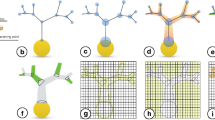Abstract
Neuron morphology reconstruction from high-resolution imaging data is essential for understanding the structure and function of the brain in neuroscience. However, previous methods cannot achieve both water-tight and high performance in surface mesh reconstruction of large-scale neurons. Thus, this paper proposes a novel neuronal surface mesh reconstruction algorithm based on isosurface extraction, virtual memory management, and parallel computation. The space of a neuron is firstly divided into blocks, and they are organized as a sparse octree to handle large-scale neurons with long projection. We then perform voxelization and isosurface extraction on valid blocks based on the skeleton model of the neuron to ensure the generated mesh that is water-tightness, and the quality and the density of the mesh are controllable. Since each block is processed independently, the reconstruction can be performed in parallel for high performance and partially for interactive modification during neuron proofreading. Experiments demonstrate that the proposed algorithm can generate water-tight neuronal surface meshes effectively and satisfy the needs of interactive visualization and correction.
Graphical Abstract









Similar content being viewed by others
Notes
References
Abdellah M, Hernando J, Antille N, Eilemann S, Markram H, Schürmann F (2017) Reconstruction and visualization of large-scale volumetric models of neocortical circuits for physically-plausible in silico optical studies. BMC Bioinf 18:39–50
Abdellah M, Favreau C, Hernando J, Lapere S, Schürmann F (2019) Generating High Fidelity Surface Meshes of Neocortical Neurons using Skin Modifiers. In: Computer graphics and visual computing (CGVC), pp 45–53
Abdellah M, García Cantero JJ, Foni A, Roman Guerrero N, Boci E, Schürmann F (2022) Meshing of spiny neuronal morphologies using union operators. Computer graphics and visual computing (CGVC), pp 19–26
Abdellah M, Cantero JJG, Guerrero NR, Foni A, Coggan JS, Calì C, Agus M, Zisis E, Keller D, Hadwiger M, Magistretti PJ, Markram H, Schürmann F (2022) Ultraliser: a framework for creating multiscale, high-fidelity and geometrically realistic 3D models for in silico neuroscience. Brief Bioinf 24(1)
Beyer J, Troidl J, Boorboor S, Hadwiger M, Kaufman A, Pfister H (2022) A survey of visualization and analysis in high-resolution connectomics. Comput Gr Forum 41(3):573–607
Brito J, Mata S, Bayona S, Pastor L, DeFelipe J, Benavides Piccione R (2013) Neuronize: a tool for building realistic neuronal cell morphologies. Front Neuroanat 7:27–35
Garcia-Cantero JJ, Brito JP, Mata S, Bayona S, Pastor L (2017) Neurotessmesh: a tool for the generation and visualization of neuron meshes and adaptive on-the-fly refinement. Front Neuroinf 11:38
Ghaffari M, Hsu C-Y, Linninger AA (2015) Automatic reconstruction and generation of structured hexahedral mesh for non-planar bifurcations in vascular networks. In: 12th international symposium on process systems engineering and 25th European Symposium on Computer Aided Process Engineering vol. 37, pp. 635–640. Elsevier
Gleeson P, Steuber V, Silver RA (2007) neuroconstruct: a tool for modeling networks of neurons in 3d space. Neuron 54(2):219–235
Lasserre S, Hernando J, Hill S, Schuermann F, Miguel Anasagasti P, Jaoude GA, Markram H (2012) A neuron membrane mesh representation for visualization of electrophysiological simulations. IEEE Trans Visual Comput Gr 18(2):214–227
Lewiner T, Lopes H, Vieira AW, Tavares G (2003) Efficient implementation of marching cubes’ cases with topological guarantees. J Gr Tools 8(2):1–15
Lichtman JW, Denk W (2011) The big and the small: challenges of imaging the brain’s circuits. Science 334(6056):618–623
Liu Y, Wang G, Ascoli GA, Zhou J, Liu L (2022) Neuron tracing from light microscopy images: automation, deep learning and bench testing. Bioinformatics 38(24):5329–5339
Lorensen WE, Cline HE (1987) Marching cubes: a high resolution 3D surface construction algorithm. ACM Siggraph Comput Gr 21(4):163–169
Parekh R, Ascoli GA (2015) Quantitative investigations of axonal and dendritic arbors: development, structure, function, and pathology. Neuroscientist 21(3):241–254
De Santis G, De Beule M, Segers P, Verdonck P, Verhegghe B (2011) Patient-specific computational haemodynamics: generation of structured and conformal hexahedral meshes from triangulated surfaces of vascular bifurcations. Comput Methods Biomech Biomed Engin 14(9):797–802
Taubin G (1995) A signal processing approach to fair surface design. In: Proceedings of the 22nd annual conference on computer graphics and interactive techniques, pp 351–358
Ueda HR, Dodt H-U, Osten P, Economo MN, Chandrashekar J, Keller PJ (2020) Whole-brain profiling of cells and circuits in mammals by tissue clearing and light-sheet microscopy. Neuron 106(3):369–387
Zhou H, Sun P, Ha S, Lundine D, Xiong G (2016) Watertight modeling and segmentation of bifurcated coronary arteries for blood flow simulation using CT imaging. Comput Med Imaging Graph 53:43–53
Zhu X, Liu X, Liu S, Shen Y, You L, Wang Y (2022) Robust quasi-uniform surface meshing of neuronal morphology using line skeleton-based progressive convolution approximation. Front Neuroinf 16:953930
Acknowledgements
This work was supported by National Natural Science Foundation of China (61890954 and 61972343).
Author information
Authors and Affiliations
Corresponding author
Additional information
Publisher's Note
Springer Nature remains neutral with regard to jurisdictional claims in published maps and institutional affiliations.
Rights and permissions
Springer Nature or its licensor (e.g. a society or other partner) holds exclusive rights to this article under a publishing agreement with the author(s) or other rightsholder(s); author self-archiving of the accepted manuscript version of this article is solely governed by the terms of such publishing agreement and applicable law.
About this article
Cite this article
Wang, Y., Li, Y., Tao, Y. et al. Fast reconstruction of water-tight surface mesh of neurons. J Vis 27, 437–450 (2024). https://doi.org/10.1007/s12650-024-00970-6
Received:
Revised:
Accepted:
Published:
Issue Date:
DOI: https://doi.org/10.1007/s12650-024-00970-6




